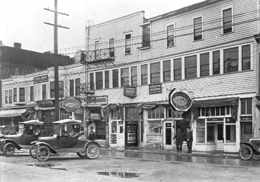This file contains Seattle historian and photographer Paul Dorpat's Now & Then photographs and reflections on the Fiore d'Italia Restaurant on 5th Avenue S in Seattle.
The Fiore d"Italia Restaurant
In 1924 or 1925, Giacomo and Maria Traverso opened their Fiore d'Italia at 414 5th Avenue S, between Jackson Street and King Street S. These Genoese cooks had the knack for fixing delicious traditional dishes, and soon Seattleites favored their cafe for serving the best Italian cooking in the city. Many regulars came from the Italian community centered in Rainier Valley.
At lunchtime Seattle garbage collectors, many of whom, like the Traversos (and like Christopher Columbus) were Genoese, preferred the aromas that wafted within this flower of Italy. Favorite dishes included: a codfish concoction called Baccala, a generously seasoned cornmeal mush called Polenta, and a meat and potatoes mix called Stufato. Every Wednesday Maria Traverso would prepare the week's noodles for the pasta of the day.
The Fiore d' Italia was Giacomo Traverso's third and most successful attempt at Italian cooking. City directories list him, in 1917 and 1918, at two other restaurants. In 1919, Giacomo was recorded by Polk Directory canvassers not as a cook but as a wartime shipbuilder. Possibly, therefore, Traverso took part in the 1919 general strike, which started in the shipyards. However, as the Traverso's daughter, Jenny Cella, recalls, her father could not be kept out of the kitchen. Soon he was cooking at another Skid Road cafe.
Fifth Avenue, south of Jackson Street, could be described as the Mediterranean western border of the International District. Other Italian establishments on the street included a grocery at the corner of Jackson. Here 5th Avenue is half a street, for it is bordered on the west by the big pit of the railroad yards and grand stations. And to the east is the East, the international community, which is still largely Asian.
This scene was photographed by one of the Traverso's Asian neighbors, Yoshiro Okawa, whose Aiko Photographic Studio was located at 6th Avenue and Jackson Street above the drug store. (The "now" photo shows United Savings at that corner.) 0kawa's fine commercial photography "at reasonable prices" was a neighborhood given -- until 1942 when the Okawa family, and all Japanese persons in the district were shipped off to internment camps.
Since they could take with them only what they could carry, Yoshiro Okawa's years of work were destroyed, including the original negative for this record of the Traverso's cafe. Luckily the print survived. And so did Okawa, to open another studio in Chicago after the war. Later he retired to Seattle where he died in 1976 at the age of 85.

